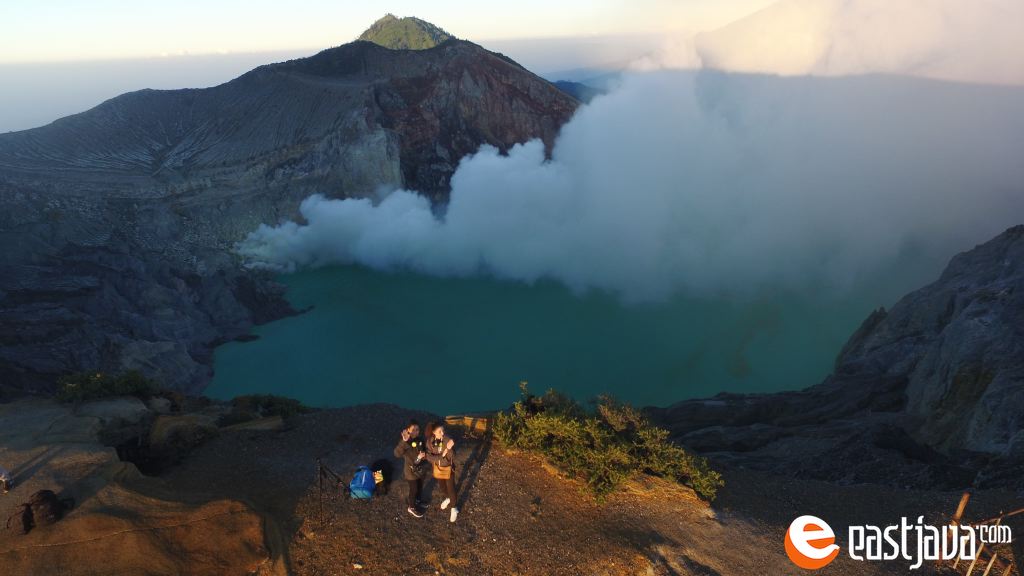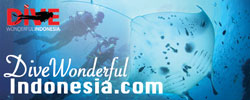Tourism Destinatons
Culture and Art
Culture and Art
Ijen Crater / Kawah Ijen - Banyuwangi

Ijen Crater is the biggest crater lake in Java. The sulfur crater lake lies between a natural dams of deeply etched rock. It is 200 meters deep and contains about 36million cubic meters of steaming acid water, shrouded in a smelling swirling sulfur cloud. Inside the crater the different color and size of stones are found. Indeed the crater of Ijen is beautiful garden of stone as well.
The view of sulfur miners who climb and go down to the crater is
also amazing. A man puts about 10 kg of yellowish stone in to his
basket, before he descends the mountain slope to sell his load,
carrying the same basket, going in the same direction, digging the
same mineral. It is the natural picture that can be seen everyday.
Ijen Plateau lies in the centre of Ijen-Merapi Malang Reserve, which
extends over much of the mountainous region directly west of Banyuwangi
and borders on the Baluran National Park in the northeast. As at
Mt. Bromo, the caldera is best viewed from the air. Fortunately,
almost all commercial flights operating between Denpasar - Surabaya,
Yogyakarta or Jakarta usually fly, if not directly over, then close
by Ijen plateau, where the seemingly luminous blue/green crater
lake forms an unmistakable landmark. It is beautiful scenery and
located about 32 km to the north west of Banyuwangi.
The principal attraction at Ijen is the large Crater Lake that has
much sulfur, which lies hidden between sheer walls of deeply furrowed
rock at more than 200 meters. The Ijen crater itself lies at approximately
2,300 meters above sea level. It forms a twin volcano with the now
extinct Mount Merapi. The enormous Crater Lake, which is 200 meters
deep and covers an area of more than meters, a million square meters,
contains about 36 million cubic meters of steaming, acid water.
Ijen crater shows a special type of volcanic feature common to Indonesia,
about 1 kilometer in diameter and 175 meters deep. The floor is
covered completely by a warm lake, milky blue green in colours held
back by a dam built many years ago by the Dutch, in order to keep
the hot, mineral laden water from raining the crop lands below.
The crater can be reached from either the east or the west by any
kinds of vehicles, but the second part of the trip covers distance
3 km on foot (jungle track). However, the latter is more popular
approach, since the climb from the road's end to the edge of the
lake is only one and a half hours. And a walk around the lake takes
a full day.
The temperature drops at night, near the crater rim it can fall
to about 5° Celsius. The road ends at Jampit, where very basic
shelter is available. It is also possible to sleep in the old vulcanology
station further up the hill, now used by sulfur collectors, but
permission must be obtained in advance.
The sulfur is transported entirely on foot. In the past, horses
were used but they were found to be less practical on the hazardous
terrain. Today, the mine yields nine to twelve tons of sulfur per
day.
Men carry individual loads of up to 70 kg, often barefooted, up
to the rim of crater and then 17 km down the mountainside to a factory
near Banyuwangi. The porters are paid by weight. The most important
advice if you are traveling to Ijen is: "If you lose your way,
just look out for the sulfur trail". The meaning was clear,
since a continuous flow of two ways traffic, carrying the sulfur
down the mountainside from the lake and trudging up again to re-load,
had left a yellow trail on the well-worn path. The best time for
seeing Ijen Crater is at 8 to 9 am.
BOOKING a HOTEL in IJEN CRATER AREA
FOR
MORE INFORMATION & PHOTO GALLERIES
ABOUT IJEN CRATER....

Gajah Oling Batik Motif Officially Becomes Banyuwangi’s Intellectual Property
The Gajah Oling batik motif typical of Banyuwangi has officially received a communal intellectual property inventory (KIK) registration letter from the Indonesian Ministry of Law and Human Rights (Kemenkumham). The Gajah Oling motif is recorded as an original Traditional Cultural Expression (EBT) of Banyuwangi. Gajah Oling is one of dozens of batik motifs in Banyuwangi. This motif is arguably the most popular compared to other motifs. Gajah Oling is a combination of the image of an elephant and an uling or a type of eel. There are several opinions in…
Indonesia By Road: 3 Routes You Should Explore
Can you envision yourself driving through a country with mesmerizing beauty, countless islands, endless beaches, and delicious cuisine? A place where you can see the Komodo dragon. What if in the same country you could get a close view of Rafflesia Arnoldi, the world’s largest flower while road tripping? Sounds too good to be real, but Indonesia, the world’s largest archipelago, according to World Vision International, is a popular destination in the world. It promises both beauty and adventure and traveling by car gives you the freedom to grasp the country’s charm…
Choice of Nature Tourism in Banyuwangi, Suitable for Family Travelers
Banyuwangi has variety of tourist options. One of them is nature tourism. This is the attraction of Banyuwangi that must be visited. Banyuwangi is rich in natural destinations, including beaches and forests. The natural destinations include Baluran National Park, Meru Betiri National Park, Alas Purwo National Park, Ijen Crater, and Marina Boom Beach. Although Baluran National Park is in Situbondo, most tourists think it is in Banyuwangi. Family tourists usually visit the beaches in Banyuwangi. One of the most visited beaches is Boom Beach, also known as Marina Boom. Marina…
Indonesia Destinations For the Sport Tourism Program
To realize the sport tourism program, Indonesia needs to choose the most potential tourist destinations, from thousands of other tours. Indonesia itself has many tourist destinations that have the potential to become a place for sport tourism. Here are some of them. Toba LakeLake Toba seems to never run out to amaze tourists through its various tourist destinations. First, you can enjoy the beauty of Lake Toba on Holbung Hill. Holbung Hill itself is in Tele Village, Samosir. This place offers another side of the beauty of Lake Toba. It…








